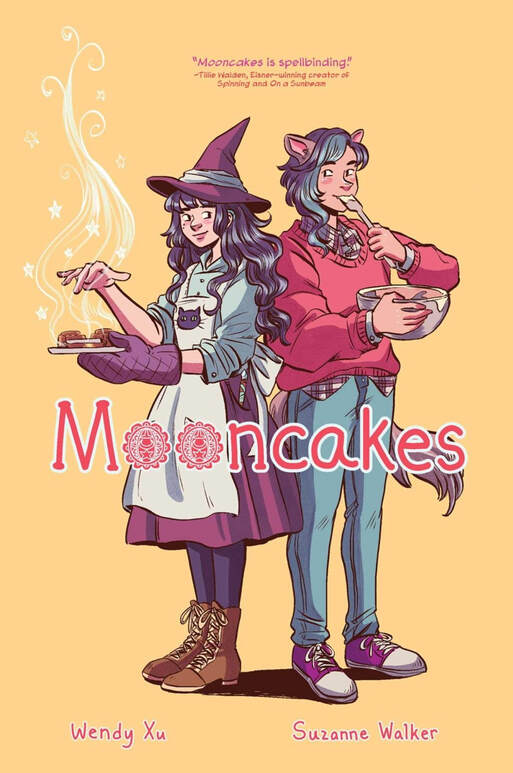|
Coming-of-age stories about young witches have definitely become a genre in young readers’ graphic novels: a means of blending fantasy and Bildungsroman, and of telling stories about gender and sexuality, sometimes about other forms of difference, and about resistance versus conformism. Generally, these witch stories offer gender-conscious, often queer-positive, fables of identity. Post-Harry Potter, but often rejecting the Potter novels’ emphasis on passing in the mundane world, they also seem influenced by Hayao Miyazaki and the magical girl franchises of anime and manga. Here are reviews of three graphic novels about witches that came out, one after another, last fall: The Okay Witch. By Emma Steinkeller. Aladdin/Simon & Schuster, ISBN 978-1534431454 (softcover), Sept. 2019. 272 pages, $12.99. A girl named Moth, a misfit in her Salem-like town, discovers that she comes from a line of superhuman witches, her mother is more than three centuries old, and her family is entangled in the history of the town and its witch-hunters. Moth’s grandmother has retreated into a timeless, otherworldly utopia for witches, while her Mom has embraced the mortal world and sworn off witchcraft. Grandmother and Mom argue over Moth’s destiny, while Moth seeks her own way. There’s an intriguing story hook in this middle-grade fantasy, which poses an ethical dilemma about retreating from, versus engaging, an imperfect world — and suggests an allegory of America, in which women of color (Moth and family) expose and challenge the culture’s white-supremacist and patriarchal origins (the witch-hunters). However, The Okay Witch seems tentative and underthought, hobbled by blunt exposition, shallow characterization, and patchy drawing. Steinkellner’s characters are designedly cute and expressive (her style reminds me of Steenz), and she seems to grow into the work as she goes, but the results are unsteady. The breakdowns and staging of action sometimes confuse, the settings lack texture and depth, image and text do not always cooperate, and distractions such as crowded lettering and jumbled perspectives dilute the impact. The novel is progressive, hopeful, and charming, much more than the pastiche of Kiki’s Delivery Service suggested by its cover, but still strikes me as a derivative, uncertain effort. Mooncakes. By Wendy Xu and Suzanne Walker. Lettered by Joamette Gil; edited by Hazel Newlevant. Roar/Lion Forge, ISBN 978-1549303043 (softcover), Oct. 2019. 256 pages, $14.99. Mooncakes is a Young Adult fantasy about witches, werewolves, and demons, set in a world where magic is — well, not commonplace, but not unheard of either. More than that, it’s a gentle romance between two sometime childhood friends, now young adults: Nova, a witch who lives and works with her grandmothers (also witches); and Tam, a genderqueer werewolf and a refugee, running from cultists who seek to exploit their power. Even more, though, Mooncakes is a paean to community: a culturally diverse, queer one that helps Nova and Tam bind demons and face down their adversaries. The complicated plot hints at a world in which the relationships between technology and magic, humans and spirits, and the living and dead could take volumes to explore. Xu’s drawing is organic and expressive, her pages lively variations on the grid, with occasional dramatic breakouts. The settings are richly textured, the colors thick, a tad cloying. The emotional dynamics are enriched with grace notes of characterization (Xu and Walker know when to take their time). That Nova is hard of hearing is a point gracefully handled, neither central nor incidental. The story is finally a bit too pat, and reworks some shopworn elements — again, there’s that whiff of Miyazaki, with animal spirits and talk of a young witch’s apprenticeship. Yet the distinct characters and budding romance make it click. The Midwinter Witch. By Molly Knox Ostertag. Color by Ostertag and Maarta Laiho; designed by Ostertag and Phil Falco. Scholastic/Graphix, ISBN 978-1338540550 (softcover), Nov. 2019. 208 pages, $12.99. The Midwinter Witch rounds out Ostertag’s middle-grade Witch Boy trilogy — though I dearly wish this wasn’t the last book, since she has created such a beguiling world and winning family of characters. The series keeps getting better, and this volume hints at conflicts and potential that could sustain even deeper explorations. Here, Aster (the gender-nonconforming “witch boy”) and Ariel (a character introduced in the second book, The Hidden Witch) and their friends attend the Midwinter Festival, a yearly reunion of Asher’s extended family. There they compete in a tournament that requires each of them to face their fears: Aster’s of defying a strictly gendered tradition, Ariel’s of not fitting in, of being the orphan and odd witch out. Acerbic and defensive, Ariel is not sure she can become part of Asher’s very welcoming family. A dark force from her past looms up, luring her to a different path and leading to a confrontation that is all too quickly resolved — I wanted to know more about Ariel’s particular darkness and its source. The payoff, though, is lovely and affirming. The Midwinter Witch is a remarkably sure-handed work of cartooning, enlivened by deft, often silent, characterization, artfully designed pages that mix the grid with bleeds and multilayered spreads, and felicitous coloring. Overall, it’s a marvel of elegant, empathetic storytelling — a new high for Ostertag. By way of conclusion, I invite KinderComics readers with insights into this genre to weigh in with comments! I'd love to hear from readers with a strong interest in this kind of story; I'm eager to gain a fuller sense of the witch's tale, where it comes from, and what it might mean for culture and for comics. I see literary, cinematic, and anime/manga influences in this genre, but still find myself wondering, why is the witch's tale flourishing now, as a comics genre? How does the treatment of the witch's tale in comics differ from its treatment in prose?
1 Comment
|
Archives
June 2024
|




 RSS Feed
RSS Feed
